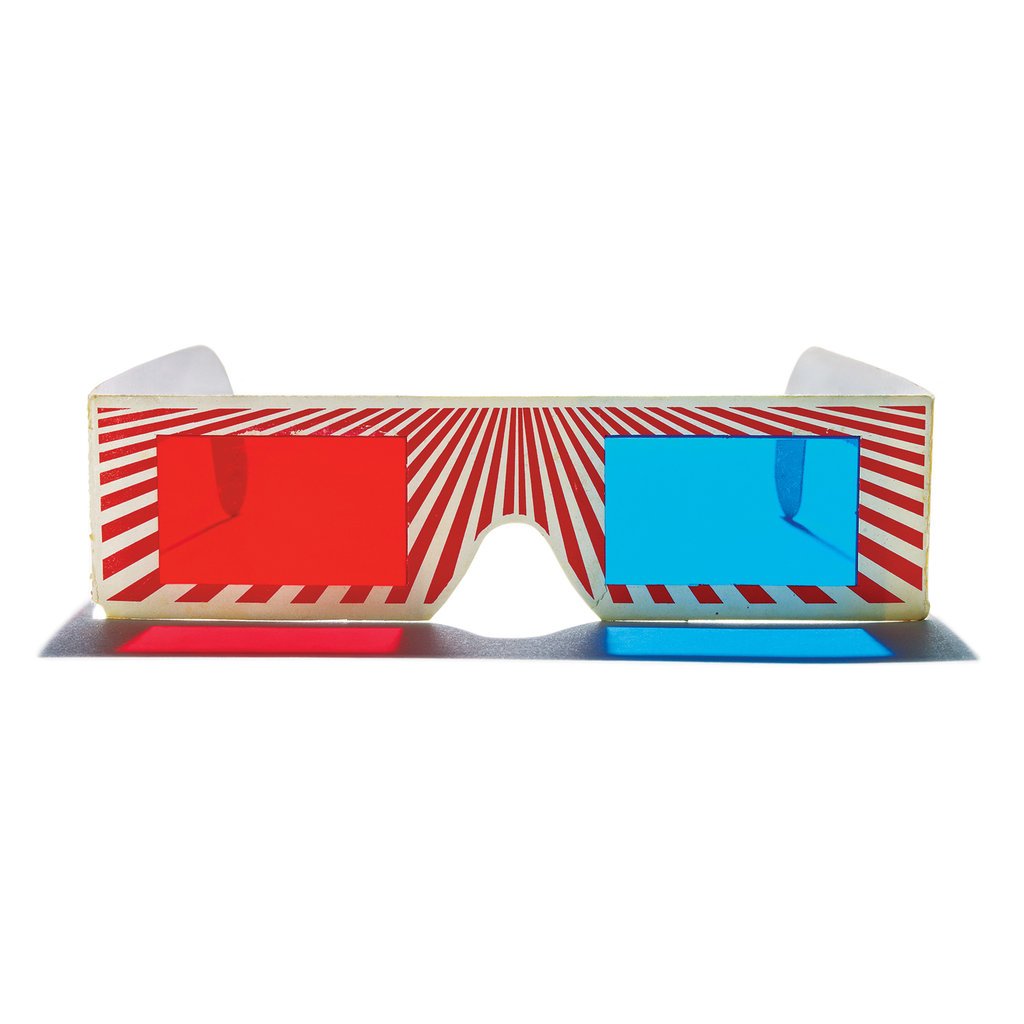|
One morning in 1915, curiosity-seekers filed into the Astor Theater in New York for a new cinematic spectacle. As two film projectors rattled to life, the audience was immersed in a wonderland. “Hills, valleys, houses, the figures on a country road,” wrote Lynde Denig, a reporter who attended the screening, “the effect is marvelously real.”
1915年的一个清晨,猎奇者们涌进纽约阿斯特剧场欣赏全新的电影奇观。随着两台电影放映机吱吱嘎嘎地转动起来,观众们沉浸在一个奇妙的世界。“小山、谷地、房屋和乡村道路上的人们,这效果简直栩栩如生,”来参加放映的记者林德·丹尼格(Lynde Denig)写道。
Denig loved the illusion of depth, but he hated the cardboard viewer, with its red and green lenses, that he had to hold in front of his face. After half an hour, his arm ached. And when he took a “disillusioning glimpse at the screen with the naked eye,” he shuddered. Because each of the films was tinted — one red, the other green — the people on screen looked like “hobgoblins.”
丹尼格喜欢这立体的感觉,但他讨厌必须举在眼前的取景器,它有红绿两个镜片。半小时后他的胳膊就开始酸疼。当他“用肉眼向屏幕投去脱离幻觉的一瞥”时,不禁全身颤抖,因为每一帧胶片都是被染过色的——一层红色、一层绿色——银幕上的人看上去活像“妖怪”。
But in most respects the show was a success. Put on by the director Edwin Porter and his partner William Waddell, it built an experience out of a hodgepodge of footage — including shots of Niagara Falls. The point wasn’t the plot but to prove that the brain could be tricked into seeing images in three dimensions. The red-and-cyan 3-D system that grew out of their experiment enjoyed a brief vogue in the 1920s. But the technology worked only with a limited palette. Edwin Land would solve that problem by inventing polarized lenses in 1936, which worked in full color. These ushered in a new wave of 3-D mania when the technology made its way to Hollywood in the 1950s. At the same time, cheap red-and-cyan glasses based on the earlier system became popular in the world of comic books and B-movies.
但是这场放映在很多方面都很成功。影片导演是埃德温·波特(Edwin Porter)和搭档威廉姆·沃德尔(William Waddell),它是根据一系列镜头呈现出的体验,其中还有尼亚加拉瀑布的镜头。影片的重点不在于情节,而是证明了大脑可以被欺骗,看到银幕上出现三维的景象。在他们实验的基础上发展起了红绿3D系统,20世纪20年代曾短暂风靡一时。但这种技术只适用于有限的色彩。后来埃德温·兰德(Edwin Land)在1936年发明了偏光镜(polarized lenses),可以拍摄全色彩,从而解决了这个问题。20世纪50年代,3D技术又为好莱坞所用,从而引领了一波3D新狂潮。与此同时,按照早期技术制成的便宜的红绿眼镜也开始普遍用于看漫画书和B级片。
“Every 20 to 30 years, you get this craze for 3-D movies,” says Jack Theakston, a historian with the 3-D Film Archive, which then burns out. Today’s “Avatar”-inspired boom is very likely no exception, Theakston says. Inventors, meanwhile, continue to work on the holy grail: 3-D effects with no glasses.
“每隔20到30年都会有一次3D电影狂热,”史学家杰克·西克斯顿(Jack Theakston)说,他曾有一个3D电影档案室,后来不幸烧毁了。他说,如今由《阿凡达》(Avatar)引发的狂潮也不例外。而发明家们还在努力达到他们的终极目标——不戴眼睛也能看出3D效果。

A VISION THING
视觉效果
Victor K. McElheny is the author of “Insisting on the Impossible,” a biography of Edwin Land.
维克多·K·麦克艾尔亨尼(Victor K. McElheny)是埃德温·兰德传记《坚持不可能》(Insisting on the Impossible)的作者。
In the iconic 1950s Life magazine photo of a 3-D movie premiere, was the audience wearing the lenses developed by Land?
Yes. Those glasses were sold by the millions. But there were a lot of problems in the ’50s. Projectionists had to run two strips of film at the same time. If the projectionist was a little slack and the films went out of sync, the people in the audience would get a headache. And there was an intermediate market for cheaper glasses — knockoffs that weren’t so well made — and they would give you a headache, too.
《生活》杂志20世纪50年代有一张标志性的3D电影首映式照片,里面的观众戴的是兰德研发出来的眼镜吗?
是的。那些眼镜卖出了成千上百万副。但是50年代的3D电影有很多问题。放映员得同时放两条胶片。如果放映员粗心了,这两条胶片就同步不上,观众会看得头痛。另外便宜的3D眼镜占领了中间市场,它们都是仿冒品,做工很差,戴它们看东西也会让人头疼。
These polarizing lenses delivered a different image to each eye?
Yes, one eye would see one set of signals, and one eye would see another.
偏光镜是不是让两只眼睛各自看到不同的图像?
是的,每只眼睛各看到一组视觉信号,另一只眼睛看到另一组信号。
You worked as a writer at Polaroid during the early 1970s. What were your impressions of Land?
He had a movie-star quality; a lot of people thought he looked like Cary Grant.
20世纪70年代初,你就写过关于宝丽莱公司(Polaroid)的东西,你对兰德怎么看?
他身上有影星的特质;很多人都觉得他长得像加里·格兰特(Cary Grant)。
3-D MILESTONES
3D史上的里程碑
19th century: The stereoscope
The hand-held device worked for still images, but this technology was difficult to translate into film.
19世纪:立体镜(stereoscope)
这是一种手持装备,用于拍摄静物,这种技术很难用到电影拍摄中。
1920s: Anaglyph 3-D
Plastigram films toured the country, bathing the screen in red and blue and offering a first taste of the third dimension.
20世纪20年代:浮雕3D(Anaglyph 3-D)
“塑料电影”(plastigram)在全国巡回演出,屏幕上是红蓝两色,带给观众3D立体效果的初体验。
1950s: Polarized 3-D
“Bwana Devil” helped to start another 3-D fad. The poster promised to put “a lion in your lap.”
20世纪50年代:偏光镜3D
《非洲历险记》(Bwana Devil)开启了新一波3D风尚。海报上承诺观众,片中会有“狮子扑到你脚下”。
2012: High-frame-rate 3-D
“The Hobbit” features this new technology, along with Elton John-size specs made from faux “hammer-forged steel.”
2012年:高帧速3D
《霍比特人》(The Hobbit)采用了这种新技术,观影者戴的眼镜跟埃尔顿·约翰(Elton John)的眼镜差不多大小,是由“手工锻造的钢铁”制成的。
本文最初发表于2012年12月16日。
翻译:董楠
|
- VOA 英语教学节目
-
- 经典英语在线训练资源
-
|

